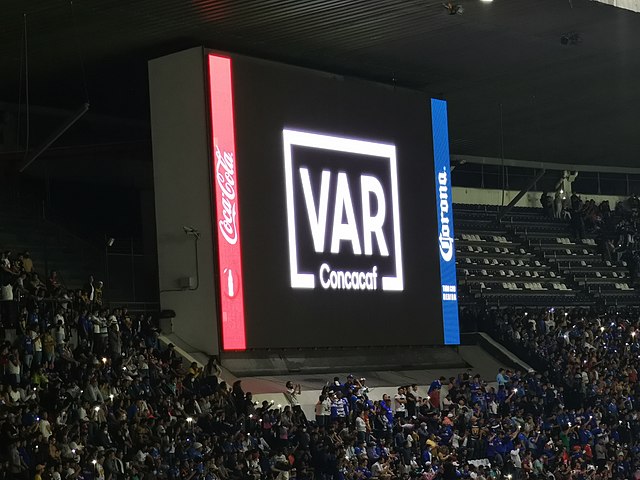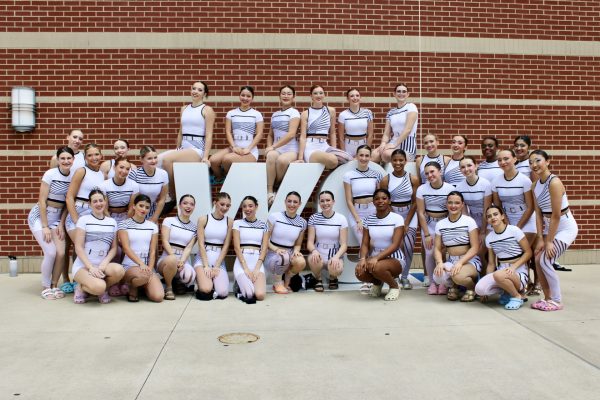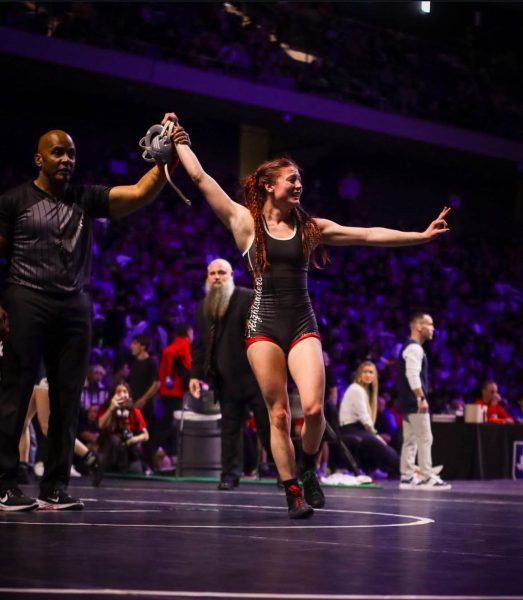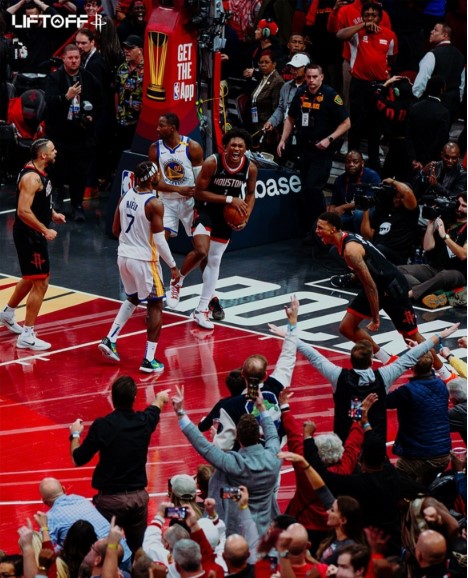VAR – A controversy that grows
Protoplasma Kid, used under Creative Commons Attribution-Share Alike 4.0
Video assistant referee displayed on the scoreboard at Estadio Azteca, April 2022.
When VAR was introduced to the English Premier League in the 2019/20 season, it was meant to get rid of the human error mistakes made in games such as offsides and handballs. Although the only thing it has brought to the league is controversy and speculation. Over the past three years a question has been constantly raised; has VAR truly brought good to the game?
VAR is an acronym for Video Assistant Referee. The system works by placing cameras all over the stadium facing the pitch which a referee monitors in a room at VAR headquarters. The main referee in the center of the field contains a mic and a hearing piece that directly connects them to the referee monitoring the cameras at the game.
The VAR referee has a role to play in goals, penalties, and red cards. Whenever a goal goes in, it is the VAR referee’s job to check for offsides, handballs, or fouls leading up to the goal. If everything is good the goal stands. If a goal is scored but is ruled offside by a linesman at the game, VAR will review the offside decision with the possibility of overturning it if it’s wrong. Whenever there is a claim of a foul or handball in the penalty box or a penalty is given, VAR can review the situation and if they feel that the referee has made a mistake they will send the main referee to a pitch-side monitor in order for them to review it with their own eyes and can come to a new decision or stick to their original decision on the penalty. Red cards work in a similar way to penalties. VAR reviews a foul that they might feel is a red or a red that was given that they feel isn’t serious enough for a red. The main referee is then sent to the monitor for them to review and come to a decision.
On the surface, VAR looks like a great addition to the beautiful game. I and many others were excited for its addition. Clear mistakes would be eliminated and fans could go to sleep happy knowing the game was decided fairly and justly. Well, that wasn’t exactly how this fairytale unfolded.
In its inaugural season, VAR reviewed more than 2,400 incidents across 38 game weeks and ended up overturning 109 decisions made by the referees at the game. This season brought to light the first big problem and the big question about VAR; how close is too close for an offside? Offside is a simple rule, you can’t be past the last defender when the ball is passed to you. People didn’t consider that even if two players look in line, one of them has to be further even if it’s by the slimmest of margins. When reviewing a goal for offside, VAR draws lines on the camera in order to tell who is further. A problem though is that any body part can be used to show your furthest position. This means that an attacker’s foot can be used against a defender’s shoulder and vice versa. When drawing lines it is practically impossible to compare the difference between the two since one is in the air and the other is on the floor. Because of this, goals were being ruled out for the slimmest of margins, from literal centimeters to the lengths of an armpit. One of the clearest examples of these margins is when Aston Villa winger Grealish had a goal ruled out after his heel was ruled offside by a margin that is impossible to see from the naked eye, no matter how much you squint. It was one of several harsh decisions made by VAR that season. What people need to understand though is that there is a difference between harsh and true. If the technology being used is correct every time, which it should be if they are going to use it, then offside is an offside. Even if it is close, harsh, or seems unfair, if the attacker is past the last man it needs to be called offside.
VAR isn’t only about using technology to make pinpoint accurate decisions. The person controlling the VAR is still another human which means that for everything, other than offsides, decisions are still subjective.
The “Clear and Obvious” rule was also added to the rules referees have to follow when dealing with VAR. “Clear and Obvious” means that VAR will only intervene if they feel that the incident deserves to be looked at. This rule is understandable because not all fouls in the box can be reviewed so only the “obvious” ones are checked. Well, then what is considered obvious? People will always talk over what isn’t taken to VAR, especially when there were decisions that you look back on and think how in the world wasn’t that reviewed at least such as Harry Maguire wrestling Azpilicueta to ground in the box. If that had been reviewed I am sure it would’ve been called a penalty.
Another issue of subjectiveness is handballs. Although handballs seem relatively subjective, you have to think about the intentionality of it and what they call an “unnatural position”. Referees and VAR will decide if a handball is given if the defender’s arm is not in what they consider a natural position for that arm to be in. Again, the subjectiveness of what is natural and what isn’t is different between all referees so even the VAR referee and the main referee could see a situation differently but the main referee isn’t given the chance to look at it again if the VAR referee doesn’t deem it unnatural. Another issue of handball is the bias toward defenders over offense. If a goal is scored but anywhere within the build-up play was touched by a player’s arm, even if it was just by the tip of a finger, the goal is immediately ruled out without a second thought. While on the other hand, some players are getting away with the ball hitting their arm a foot away from their body. It is ridiculous that a defensive handball can be so subjective but an offensive can’t be.
Have you ever seen someone slapped in the face in slow motion? It probably looked way worse than it does in real-time. That is exactly the problem being created by the VAR review of fouls and red cards. A camera is able to tell you exactly where a player touches another player, from that we can establish contact. Soccer is a contact sport, there are always going to be fouls. Some fouls are worse than others and that’s what leads to yellow and red cards. Another big factor in those cards is the force behind a foul. In real time it may be hard to see the position of a tackle and that’s where VAR can be useful but when they only decide to show a challenge in slow motion everything is going to look worse than it really was.
This season it has become blatantly obvious what’s going to happen every time VAR gets involved. This season not a single main referee has stuck to their decision after being called over to the monitor for revision by VAR. A very important word in VAR is assistant. It was purely meant to correct offsides and show the main referees a replay of in-game incidents. It is not meant to be the deciding factor in every decision made. Many referees feel as if they are obligated to overturn their decisions because another referee didn’t agree with them. A lot of the decisions overturned are controversial and the referee could’ve easily stuck to their decision because it is still unclear after reviewing the cameras. Instead, they decide to give in to someone at a computer miles away from the game. It feels as though VAR has become a puppet master controlling the outcome of every game as they see fit. Referees are meant to be respected and proud judges of the beautiful game, now they are merely a dog being told commands.
Even after all these problems, VAR was still a necessary introduction to the game. The problems that it was meant to solve have been solved, even if people feel that it is “unfair” and “ruining the beautiful game” because they can’t come to terms with a correct mathematical decision. Now in no way, shape or form is VAR a perfect system. It has brought a whole new can of worms with it. The rules have become unclear and too much power has been given to VAR that now even the main referees are falling to its spell. But these problems can be fixed. VAR is meant to be an assistant and the Premier League needs to treat it that way.
Have a meeting and come together to review the controversial incidents popping up every week. An understanding needs to be made between the referees as well that whoever is running the game at the actual game is confident in themselves. They can make mistakes and when those mistakes are actually obvious then that’s where VAR can shine but when the incident is as subjective as it was before the replay then the referees need to have some confidence and run this game the way they see fit. Decisions are always going to upset people but they need to make sure that at least they believe in the decision they make. These are still early days of VAR so problems are to be expected but if the appropriate action is taken VAR can fulfill the potential we were promised.
Your donation will support the student journalists of The Woodlands High School. Your contribution will allow us to purchase equipment and cover our annual website hosting costs.







